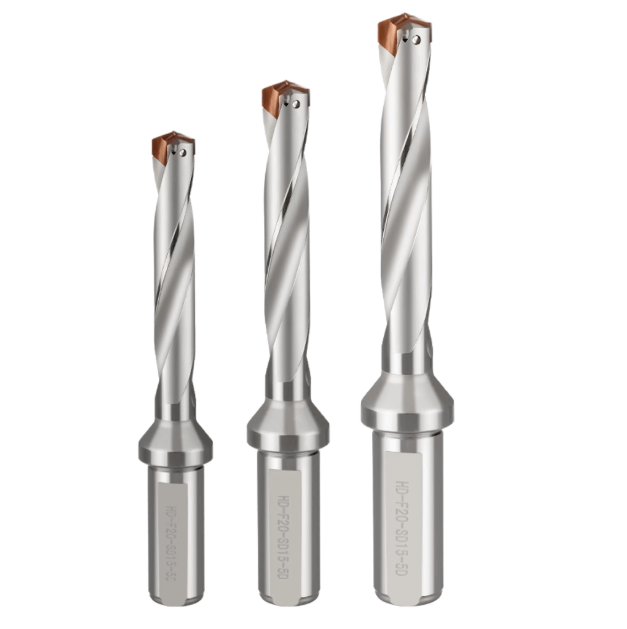In production line machining, selecting and procuring the right U drill bit size is critical for ensuring holemaking efficiency and precision. Different machine types, material properties, and drilling depths directly impact tool size and structure compatibility. Improper selection can lead to hole diameter errors, chip accumulation, premature tool wear, and increased tool replacement frequency, which in turn raises production downtime and operational costs.
Faced with diverse application scenarios, engineers often balance between metric vs imperial U drill bit sizes when selecting U drills. They also need to consider material properties, such as whether U drill bits for carbon steel provide sufficient rigidity and effective chip evacuation. In addition to standard specifications, more manufacturers are exploring custom U drill bit sizes to meet specific hole diameters, toolholder interfaces, or deep hole machining requirements.
Understanding how to choose the right U drill bit size is crucial for quickly selecting the most suitable tool from a wide range of options. This involves matching hole diameter to toolholder, coordinating the insert type with the coolant system, and considering the impact of overall tool combination on production line efficiency. During bulk purchasing, identifying cost-effective and reliable U drill bit suppliers is also key for production managers and procurement teams.
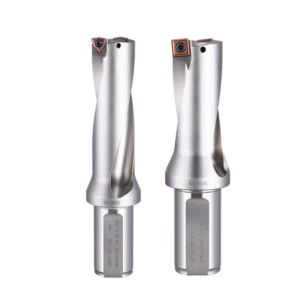
Why the Correct Selection of U Drill Bit Size is Crucial for Production Lines
Selecting the correct U drill bit size directly affects holemaking accuracy, tool life, and overall production efficiency. For companies focused on stability and batch consistency, U drills are not just holemaking tools—they are a core component of the cutting system influencing process reliability. Oversized or undersized tools can cause abnormal drilling resistance, poor cooling, hole diameter deviations, and uneven tool load, impacting both quality and cycle time.
Different working conditions, such as carbon steel, stainless steel, cast iron, or high-hardness materials, require optimal matching of tool diameter, flute length, and drilling depth ratio. Correct U drill bit size selection maximizes machine efficiency, extends tool life, and ensures cutting stability, making it a key decision in mass production planning and tool management systems.
Impact of Size Selection on Machining Accuracy and Hole Diameter Consistency
The right U drill bit size ensures consistent hole diameter and surface finish. When the diameter matches the workpiece, cutting forces distribute evenly, minimizing tool wobble and vibration. Deviations can result in overcut holes, poor surface finish, and challenges during finishing operations.
Compatibility between tool size and the toolholder interface also affects concentricity and machining stability. On high-precision production lines, engineers often compare dimensional tolerances and machining data from multiple U drill bit suppliers to ensure consistent results. Accurate dimensional control improves hole diameter consistency, reduces rework, and lowers scrap, enhancing overall production cost-effectiveness.
How the Right U Drill Bit Size Reduces Tool Change and Downtime Costs
Selecting the proper U drill size significantly extends tool life and minimizes downtime. A balanced size-to-drill depth ratio ensures uniform cutting forces and stable insert load, preventing premature chipping and wear. When the U drill size aligns with cutting parameters (speed, feed rate, and coolant flow), tool thermal load decreases, inserts last longer, and production interruptions due to frequent tool changes are minimized.
For high-volume production, reduced downtime lowers cycle time and maintenance costs. Optimizing U drill bit sizes therefore represents both a technical and an economic decision that directly influences production efficiency.
Achieving Stable Cutting and High Efficiency in High-Volume Production
In continuous machining, the right U drill bit size is essential for stable cutting. Proper diameter-to-drill-depth ratios maintain chip evacuation efficiency, preventing hole damage or tool breakage. Well-sized U drills optimize spindle power, coolant flow, and insert geometry, enabling extended continuous cutting.
Using U drill bits for carbon steel or custom U drill bit sizes can further improve stability and efficiency. Scientific size selection and tool parameter optimization ensure consistent product quality and higher output per unit time, laying a foundation for overall manufacturing cost control.
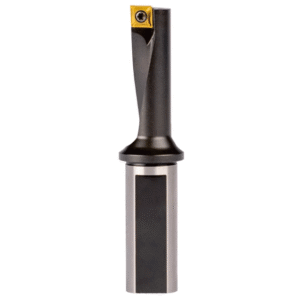
Comparison of U Drill Bit Sizes under Different Standard Systems: Metric vs. Imperial U Drill Bit Sizes
Global manufacturing often faces challenges arising from differences in standard systems. Some regions primarily use the metric system (millimeters), while others use the imperial system (inches). Differences in dimensional marking, tool interfaces, and inventory management create hurdles for international production lines.
Understanding metric vs imperial U drill bit sizes is crucial for manufacturers serving multiple regions. Metric U drills often follow standard diameters (e.g., Φ10, Φ12, Φ14 mm), while imperial sizes are expressed in fractional or decimal inches (e.g., 3/8″, 1/2″). These differences affect how to choose the right U drill bit size, tool compatibility, fixture matching, and supply chain procurement standardization.
Common Differences Between Metric and Imperial Dimension Systems in U Drills
Metric and imperial U drills differ in dimensional markings, tolerances, and applications. Metric sizes are common in European and Asian markets and align with ISO hole standards, while imperial sizes dominate North America, offering finer gradations for high-precision applications.
Toolholder interfaces (BT, CAT, HSK, R8) and tool model markings may not fully align across systems. For instance, a 1/2-inch imperial drill may slightly differ from a 12 mm metric drill, potentially causing positioning errors in high-precision machining. Cross-system usage requires referencing dimensional data and manufacturer recommendations for accuracy.
Standardization and Conversion Between Systems in International Production
Multinational manufacturers standardize U drill bit sizes by:
-
Establishing a unified size database mapping metric and imperial sizes.
-
Applying conversion factors (1 in = 25.4 mm) to prevent duplicate orders.
-
Using modular drill systems with interchangeable modules for flexibility.
Integration with ERP or MES systems allows digital tool management across regions, improving procurement efficiency and reducing selection errors.
Dimensional Compatibility and Inventory Management Strategies
Global production lines must maintain dual-standard inventories to ensure smooth operations. Experienced U drill bit suppliers provide comprehensive size charts and recommend optimal combinations based on material, such as carbon steel, stainless steel, or aluminum alloys. For high-precision parts or custom requirements, custom U drill bit sizes can be specified.
Effective inventory and size compatibility management reduce spare part costs and maintain high production flexibility, achieving standardized and sustainable operations.
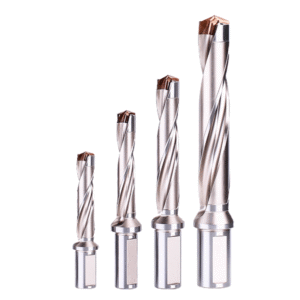
U Drill Bit Size Selection for Different Materials: Taking Carbon Steel as an Example
In production line machining, selecting the right U drill bit size depends not only on the hole diameter and machine tool type but also on the mechanical properties of the material being processed. For instance, carbon steel has moderate hardness but tends to produce long chips during cutting. Therefore, tool diameter, drilling depth ratio, and feed parameters must be carefully matched to ensure machining stability and accurate hole diameter.
Properly selecting the diameter and flute length of U drill bits for carbon steel ensures optimal chip evacuation, reduces tool wear, and minimizes machine load. In batch processing, optimizing tool size based on material properties extends tool life, reduces downtime, and improves overall production efficiency.
For manufacturers, understanding material-specific U drill bit selection principles also facilitates communication with U drill bit suppliers, whether for standard or custom U drill bit sizes, ensuring tool compatibility and reliability in production.
Typical U Drill Bit Sizes and Cutting Parameters for Carbon Steel Machining
Common U drill bit sizes for carbon steel typically range from Φ6 mm to Φ20 mm. The selection should consider both the required hole diameter and drilling depth ratio. Tool diameter and cutting depth directly impact chip formation and evacuation efficiency. Key cutting parameters include:
-
Spindle Speed (RPM): Determined by tool diameter and machine spindle power to maintain smooth cutting.
-
Feed Rate (per revolution): Matched to the number of flutes and material hardness to prevent overload and chip jamming.
-
Depth-to-Diameter Ratio: Generally recommended ≤ 5:1 to maintain hole stability and tool rigidity.
Optimizing these dimensions and parameters maximizes U drill bit performance, ensuring precise carbon steel hole machining while extending tool life and reducing production costs.
Matching Size, Drill Depth, and Feed Rate in Carbon Steel Machining
Size, drill depth, and feed rate are tightly linked in carbon steel machining. Large-diameter U drills are suitable for deep holes, but incorrect feed rates can cause problems:
-
Too low: Filamentary chips may entangle, causing jams.
-
Too high: Accelerates tool wear and may break the cutting edge.
Engineers optimize tool matching using these strategies:
-
Diameter Selection: Choose based on required hole diameter, machine rigidity, and toolholder interface compatibility.
-
Drill Depth Ratio Control: Maintain a reasonable depth-to-diameter ratio to avoid wall vibration or oversized holes.
-
Feed Rate Optimization: Adjust according to flute count, material hardness, and cooling conditions to ensure effective chip evacuation without reducing tool life.
Scientific matching of these parameters ensures the correct U drill bit size, achieving high precision, stability, and cost-effectiveness in carbon steel machining.
Size Comparison for Other Common Materials
Different materials require adjustments in U drill bit size and cutting parameters:
-
Stainless Steel: High hardness and work hardening require slightly larger diameters and lower feed rates; coolant supply is critical.
-
Aluminum Alloy: Soft material with short chips benefits from smaller diameters and higher feed rates, increasing processing speed.
-
Cast Iron: Brittle material; medium diameters and controlled speed prevent hole wall cracking.
Comparing material-specific sizes helps engineers quickly determine the optimal standard or custom U drill bit sizes for each process scenario, improving hole quality and production efficiency.
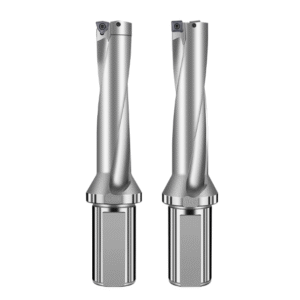
How to Choose the Right U Drill Size to Match the Machining Process
In production line machining, choosing the optimal U drill bit size is critical for achieving precise holes, maximizing tool life, and ensuring production efficiency. Size selection affects not only hole diameter consistency and cutting stability but also chip evacuation efficiency, coolant effectiveness, and wear rate. Engineers and procurement teams must consider material type, drill depth, and machine tool compatibility to select the most suitable U drill bit size for each process.
A systematic approach helps prevent common machining issues such as hole diameter deviation, premature tool wear, and production downtime. During procurement, clarifying size standards and compatibility with suppliers ensures selection of the right standard or custom U drill bit sizes for your production needs.
How to Choose the Right U Drill Bit Size: Starting with Hole Diameter and Toolholder
The first step in U drill bit selection is considering the required hole diameter and the toolholder interface. The hole size determines the drill diameter for accuracy, while the toolholder type (BT, CAT, HSK, R8) affects rigidity and stability.
Key considerations include:
-
Hole Accuracy Requirements: Tighter tolerances require higher-precision U drill bit sizes.
-
Toolholder Compatibility: Ensure full compatibility with the machine spindle to avoid vibration or eccentricity.
-
Material Type: Match drill diameter and flute length to the material’s hardness and chip formation characteristics.
Screening tools by hole diameter and toolholder ensures unsuitable models are eliminated early, laying the foundation for optimized machining.
Determine the Appropriate Size Based on Drill Depth, Cutting Fluid, and Insert Type
Proper U drill bit sizing also requires considering drill depth, cutting fluid flow, and insert type. Correct sizing ensures smooth chip evacuation and effective coolant coverage, reducing thermal load and wear.
Key strategies include:
-
Drill Depth Ratio Control: Keep depth-to-diameter ratio ≤ 5:1 for hole stability and process rigidity.
-
Cutting Fluid Optimization: Ensure effective flow to the cutting edge and hole bottom to prevent overheating or chip jamming.
-
Insert Type Matching: Adjust drill size based on insert geometry and flute count to distribute cutting forces evenly.
This comprehensive approach maximizes tool efficiency and extends tool life, especially for U drill bits for carbon steel.
Practical Tips and Common Mistakes in Avoiding Size Selection Errors
Common selection mistakes include:
-
Ignoring drilling depth ratio, causing uneven tool load or vibration.
-
Neglecting toolholder compatibility, leading to eccentricity and accelerated wear.
-
Overlooking material properties, resulting in suboptimal chip evacuation.
-
Ignoring supplier tolerance variations, causing inconsistencies.
Tips: Use a size matching table evaluating material, drilling depth, cutting parameters, and insert type. Consider custom U drill bit sizes for unique machining needs, reducing risk and improving hole quality.
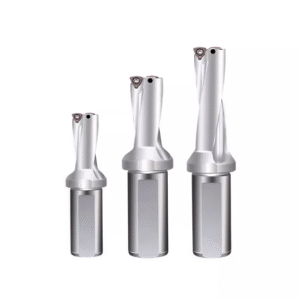
When Standard Sizes Are Not Enough: Custom U Drill Bit Sizes
In production, standard U drill bit sizes cannot always meet all holemaking requirements. This is especially true for high-precision parts, special hole diameters, or deep-hole machining, where standard sizes may fail to provide machining stability, hole accuracy, or efficient chip removal. In such cases, custom U drill bit sizes offer a practical solution to improve production efficiency and machining quality.
Custom U drills can be optimized for specific hole diameters, drilling depths, toolholder interfaces, insert geometry, and cutting parameters, addressing the requirements of materials like carbon steel or high-hardness alloys. Through scientific design and close collaboration with suppliers, custom solutions solve technical challenges that standard tools cannot, while maintaining the stability and cost-effectiveness of mass production.
When is a Custom U Drill Size Required?
Custom U drills are typically required in the following scenarios:
-
Hole diameters or drill depths outside standard ranges: Standard U drills cannot guarantee machining stability or hole diameter accuracy.
-
Special material processing requirements: High-hardness steels, titanium alloys, or composite materials may need enhanced rigidity, specific cutting angles, and optimized chip evacuation.
-
Special machine tool or fixture interfaces: When standard tools are incompatible with machine spindles or fixtures.
-
High-precision or high-volume production: Custom tools can optimize dimensional tolerances and flute configurations for repeatable results.
Clarifying these needs helps determine whether custom U drill bit sizes are necessary and avoids unnecessary costs.
Key Design Considerations for Custom U Drills
When designing custom U drills, consider the following:
-
Dimensional Optimization: Diameter, flute length, and depth-to-diameter ratio should match the hole size, material, and cutting parameters.
-
Interface Matching: Ensure compatibility with the toolholder type (BT, CAT, HSK) to maintain clamping rigidity and machining stability.
-
Insert Geometry and Quantity: Select appropriate insert angle, flute number, and cutting shape based on material hardness and chip characteristics to ensure balanced cutting forces and efficient chip evacuation.
-
Durability and Coating: Choose suitable coating or insert material to enhance wear resistance and thermal stability.
Properly designed custom U drills achieve high precision, efficiency, and minimal wear, fully leveraging the advantages of custom tooling.
Key Data to Provide When Communicating Custom Specifications with Suppliers
To facilitate custom U drill bit design, provide suppliers with:
-
Hole diameter and depth, including maximum tolerance and depth ratio
-
Material type (carbon steel, stainless steel, aluminum alloy, or high-hardness alloy)
-
Machine tool and toolholder interface specifications
-
Cutting conditions: speed, feed rate, cutting fluid type, cooling method
-
Special requirements: high-precision holes, coatings, or wear-resistant inserts
Providing accurate data ensures suppliers can design custom U drill bit sizes that meet production needs, shorten development cycles, and maintain efficiency.
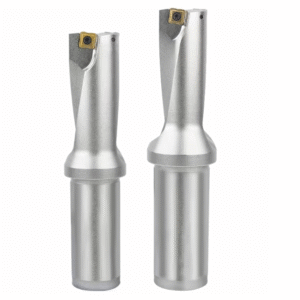
How to Find Reliable U Drill Bit Suppliers
Choosing the right supplier is key to tool quality, stability, and cost control. A reliable supplier should offer:
-
Standard and custom U drill bit sizes
-
Technical support and machining parameter recommendations
-
Expertise in customization and after-sales service
-
Consistent delivery for mass production
For multinational companies, also consider suppliers’ international delivery capabilities, compatibility with metric and imperial U drill bit sizes, and customization capacity to maintain consistent processing across production sites.
Technical Indicators and Service Standards
Evaluate suppliers based on:
-
Dimensional Tolerance and Accuracy: Compliance with ISO/DIN, consistent hole diameter and blade length
-
Tool Material and Coating Quality: High-speed steel, carbide, or diamond-coated tools
-
Technical Support: Machining parameter recommendations and material solutions
-
After-sales Service: Repair, replacement, and custom support
-
Certifications and Experience: ISO9001, CE, and years providing U drills for high-hardness materials
Comparing Suppliers’ Inventory, Lead Time, and Quality Control
Key considerations:
-
Inventory Coverage: Availability of standard and commonly used custom U drill sizes
-
Lead Time: On-time delivery for uninterrupted production
-
Quality Control: Rigorous inspection of hole diameter, cutting edges, and finished product
Compare suppliers based on inventory, delivery, price, and service to select the best option, reducing downtime and improving efficiency.
Recommendations for Long-Term Supply Relationships and Global Sourcing Trends
-
Strategic Partner Selection: Focus on suppliers with technical expertise, reliable delivery, and customization capability
-
Contract & Inventory Management: Use long-term agreements or vendor-managed inventory (VMI)
-
Technical Collaboration: Share machining parameters, material solutions, and custom tool requirements
-
Global Sourcing: Ensure metric/imperial compatibility and international delivery for multi-factory operations
Long-term partnerships help companies secure high-quality U drills, stable production, and cost-effective operations.
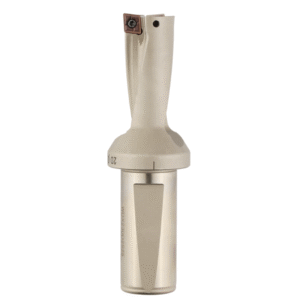
Choosing the Right U Drill Bit Size for Your Production Line Ensures Efficient and Stable Production
In modern production lines, selecting the right U drill bit size is essential for achieving efficient, stable, and high-precision holemaking. From matching hole diameter and drill depth ratio to selecting cutting parameters, material types, suppliers, and custom tooling solutions, every step directly impacts machining quality, tool life, and production costs. Correct size selection ensures consistent hole diameters, smooth chip evacuation, extended tool life, and reduced downtime, ultimately supporting high-efficiency production.
With globalized production and multi-factory operations becoming standard, companies must adopt scientific methods when choosing between metric and imperial U drill bit sizes, designing custom U drill bits, and establishing long-term supplier partnerships. This ensures a seamless match between tooling, machine tools, materials, and processes.
The Importance of Integrating Dimensional Standards, Material Matching, and Supply Chain Resources
Efficient production relies on integrating dimensional standards, processing materials, and supply chain resources. By standardizing metric and imperial sizes, selecting targeted materials—such as U drill bits for carbon steel—and optimizing inventory management, companies can maintain tool versatility and process stability across diverse production scenarios.
Additionally, leveraging supplier resources to ensure timely delivery of both standard and custom U drill bits mitigates production risks, reduces downtime, and enhances overall line efficiency.
How to Improve Overall Production Efficiency Through Scientific Selection and Supplier Collaboration
Scientific U drill selection involves more than matching hole diameter and toolholder—it also accounts for drill depth, cutting fluid, insert type, and material properties to optimize each operation.
Partnering with experienced suppliers provides technical support, tolerance control advice, and custom solutions (such as custom U drill bit sizes), improving tool performance, extending tool life, and reducing processing costs. Through effective tool selection and supply chain collaboration, companies can achieve high-efficiency, low-cost, and stable production.
Future Trend: Intelligent Tool Selection and Automated Management of Standardized U Drill Bit Sizes
With the rise of smart manufacturing and Industry 4.0, production lines increasingly rely on intelligent tool selection systems and tool management software. These systems enable automated matching and standardized management of U drill bit sizes.
By leveraging digital monitoring, machining parameter recommendations, and intelligent inventory allocation, companies can quickly select the optimal U drill size while maintaining consistent management across factories and standards. Combined with custom U drill bit technology, intelligent tool selection enhances high-precision, cost-effective, and sustainable production.



